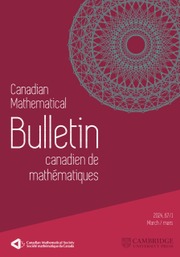No CrossRef data available.
Article contents
A Remark on Extensions of CR Functions from Hyperplanes
Published online by Cambridge University Press: 20 November 2018
Abstract
In the characterization of the range of the Radon transform, one encounters the problem of the holomorphic extension of functions defined on  ${{\mathbb{R}}^{2}}\backslash \,{{\Delta }_{\mathbb{R}}}$ (where
${{\mathbb{R}}^{2}}\backslash \,{{\Delta }_{\mathbb{R}}}$ (where  ${{\Delta }_{\mathbb{R}}}$ is the diagonal in
${{\Delta }_{\mathbb{R}}}$ is the diagonal in  ${{\mathbb{R}}^{2}}$ ) and which extend as “separately holomorphic” functions of their two arguments. In particular, these functions extend in fact to
${{\mathbb{R}}^{2}}$ ) and which extend as “separately holomorphic” functions of their two arguments. In particular, these functions extend in fact to  ${{\mathbb{C}}^{2}}\,\backslash \,{{\Delta }_{\mathbb{C}}}$ where
${{\mathbb{C}}^{2}}\,\backslash \,{{\Delta }_{\mathbb{C}}}$ where  ${{\Delta }_{\mathbb{C}}}$ is the complexification of
${{\Delta }_{\mathbb{C}}}$ is the complexification of  ${{\Delta }_{\mathbb{R}}}$ . We take this theorem from the integral geometry and put it in the more natural context of the
${{\Delta }_{\mathbb{R}}}$ . We take this theorem from the integral geometry and put it in the more natural context of the  $\text{CR}$ geometry where it accepts an easier proof and amore general statement. In this new setting it becomes a variant of the celebrated “edge of the wedge” theorem of Ajrapetyan and Henkin.
$\text{CR}$ geometry where it accepts an easier proof and amore general statement. In this new setting it becomes a variant of the celebrated “edge of the wedge” theorem of Ajrapetyan and Henkin.
Information
- Type
- Research Article
- Information
- Copyright
- Copyright © Canadian Mathematical Society 2008

